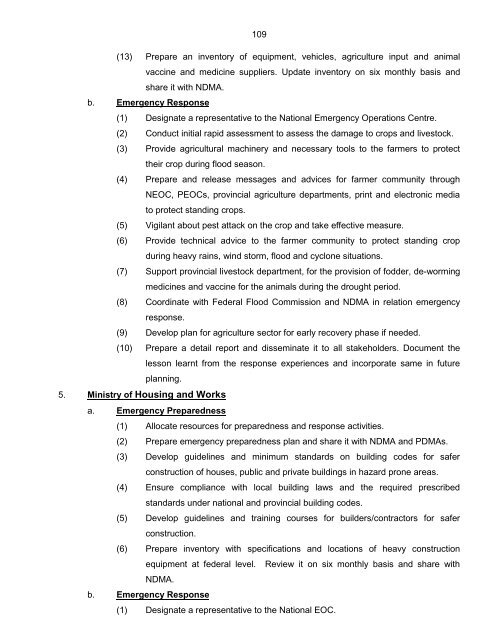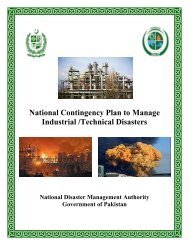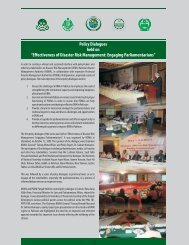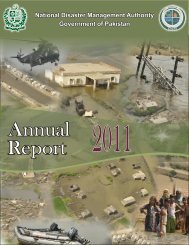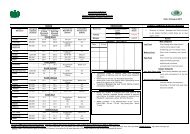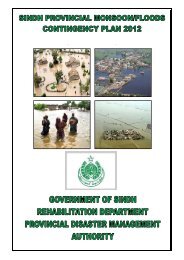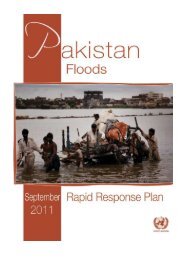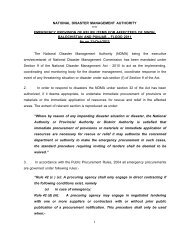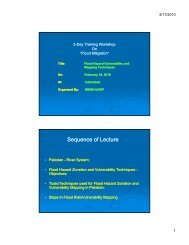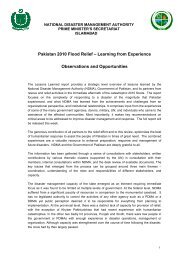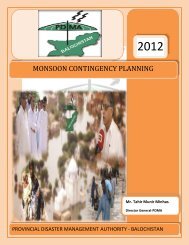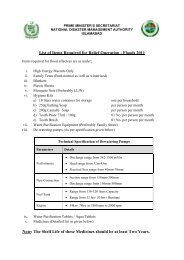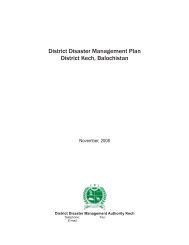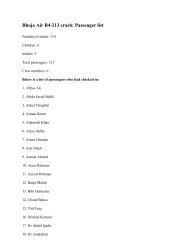National Disaster Response Plan (NDRP) March 2010 - NDMA
National Disaster Response Plan (NDRP) March 2010 - NDMA
National Disaster Response Plan (NDRP) March 2010 - NDMA
Create successful ePaper yourself
Turn your PDF publications into a flip-book with our unique Google optimized e-Paper software.
109<br />
(13) Prepare an inventory of equipment, vehicles, agriculture input and animal<br />
vaccine and medicine suppliers. Update inventory on six monthly basis and<br />
share it with <strong>NDMA</strong>.<br />
b. Emergency <strong>Response</strong><br />
(1) Designate a representative to the <strong>National</strong> Emergency Operations Centre.<br />
(2) Conduct initial rapid assessment to assess the damage to crops and livestock.<br />
(3) Provide agricultural machinery and necessary tools to the farmers to protect<br />
their crop during flood season.<br />
(4) Prepare and release messages and advices for farmer community through<br />
NEOC, PEOCs, provincial agriculture departments, print and electronic media<br />
to protect standing crops.<br />
(5) Vigilant about pest attack on the crop and take effective measure.<br />
(6) Provide technical advice to the farmer community to protect standing crop<br />
during heavy rains, wind storm, flood and cyclone situations.<br />
(7) Support provincial livestock department, for the provision of fodder, de-worming<br />
medicines and vaccine for the animals during the drought period.<br />
(8) Coordinate with Federal Flood Commission and <strong>NDMA</strong> in relation emergency<br />
response.<br />
(9) Develop plan for agriculture sector for early recovery phase if needed.<br />
(10) Prepare a detail report and disseminate it to all stakeholders. Document the<br />
lesson learnt from the response experiences and incorporate same in future<br />
planning.<br />
5. Ministry of Housing and Works<br />
a. Emergency Preparedness<br />
(1) Allocate resources for preparedness and response activities.<br />
(2) Prepare emergency preparedness plan and share it with <strong>NDMA</strong> and PDMAs.<br />
(3) Develop guidelines and minimum standards on building codes for safer<br />
construction of houses, public and private buildings in hazard prone areas.<br />
(4) Ensure compliance with local building laws and the required prescribed<br />
standards under national and provincial building codes.<br />
(5) Develop guidelines and training courses for builders/contractors for safer<br />
construction.<br />
(6) Prepare inventory with specifications and locations of heavy construction<br />
equipment at federal level. Review it on six monthly basis and share with<br />
<strong>NDMA</strong>.<br />
b. Emergency <strong>Response</strong><br />
(1) Designate a representative to the <strong>National</strong> EOC.


